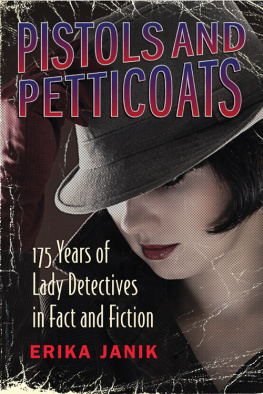2012 by the Board of Trustees
of the University of Illinois
All rights reserved
Manufactured in the United States of America
1 2 3 4 5 C P 5 4 3 2 1

This book is printed on acid-free paper.
All photographs courtesy of Granada Television/
ITV/Rex USA unless noted otherwise.
Library of Congress Cataloging-in-Publication Data
Cavender, Gray, 1947
Justice provocateur : Jane Tennison and policing
in Prime suspect /
Gray Cavender and Nancy C. Jurik.
p. cm.
Includes bibliographical references and index.
ISBN 978-0-252-03719-1 (hard cover : acid-free paper)
ISBN 978-0-252-07870-5 (pbk. : acid-free paper)
ISBN 978-0-252-09431-6 (e-book)
1. Prime suspect (Television program)
2. Women on television. 3. Sex role on television.
4. Television cop showsGreat BritainHistory and criticism.
I. Jurik, Nancy C. II. Title.
PN1992.77.P67C38 2012
791.45'72dc23 2011052788
Acknowledgments
We are grateful to ITV/Granada Productions and Rex USA for granting us permission to use their Prime Suspect images in this book. However, none of the contents of this publication is intended to imply that it is endorsed by the programs broadcasters or production companies involved. We appreciate technical assistance from Kevan Mitton and the Film and Media Studies Lab at Arizona State University. We also thank colleagues who have helped us in so many ways during our work on the Prime Suspect series: Madelaine Adelman, Jane Aiken, David Altheide, Aaron Baker, Jennifer Brown, Susan Caringella, Anne Catalano, Rebecca Dobash, Russell Dobash, Jeffrey Dunne, Gabriel Garcia-Merritt, Crystal Griffith, Frances Heidensohn, Drew Humphries, Deborah Jermyn, Paul Knepper, Eric Margolis, Linda Mizejewski, Elsie Moore, Mary Romero, Tim Rowlands, Elizabeth Stanko, Marjorie Zatz, and UIP reviewers and staff. We also want to thank the students of Juriks fall 2010 Women and Work course and Cavenders spring 2011 Justice and the Media course for their insights regarding Prime Suspect, The Closer, and The Wire. Several women police officers and administrators at the London Metropolitan Police were kind enough to speak with Nancy Jurik about their work experiences, work/life balance, and views of media images such as those in Prime Suspect. Of course, the analysis and arguments offered in the book are our own. We are equal coauthors of this book.
Introduction
Prime Suspect (Granada Television) is one of the most popular British television exports to the United States and around the globe. The series chronicles the career and personal life of Jane Tennison, initially a detective chief inspector (DCI) and later a detective superintendent (DS) for the London Metropolitan Police. Dame Helen Mirren plays Tennison, a woman officer who solves tough cases that expose complex social injustices, all the while fighting her way up the ranks of the male-dominated organization of British policing. In one Prime Suspect episode, her dad characterizes Tennisons passionate pursuit of justice:
You know, up until the age of twelve you were an angel. Youd light up a room, and then bangovernight you were a teenager. You ran us ragged, and it got worse, into this, into that, so certain, so bloody-minded, you couldnt leave anything alone. You terrified me, but you know what? I didnt mind, I was so proud. You had convictions. Well, I buried mine at that [concentration] camp. All I wanted was your mother, a steady job, children, and nothing to do with the evil I saw at that camp. But here you are, having to deal with it again. But you will. You will. You know whats right, and youll do it.
There have been seven Prime Suspect installments. Each episode runs approximately three to four hours, allowing for in-depth character and plot development. The first episode, Prime Suspect 1, aired in 1991 in the United Kingdom on ITV1 on two successive nights and in 1992 in the United States in weekly installments that lasted a month. The seventh and last episode, Prime Suspect 7: The Final Act, aired in 2006 in the UK and in 2007 in the United States. With more than fourteen million viewers in the UK alone, Prime Suspect was ranked first place in popular British Television Channel 4s Top 10 TV Cops (Jermyn 2003, 61). In the United States the programs were broadcast on the Public Broadcasting System (PBS) series Mystery! and indeed Prime Suspect has been the most popular film series in Mystery! program history. It was so popular that PBS relocated Prime Suspect to its flagship venue, Masterpiece Theater, for some of the episodes. A US version of the series premiered in the fall of 2011 on NBC network television. The rights for distribution of this US version were sold to several countries, but the fate of the series for spring 2012 is still uncertain due to low audience ratings.

Jane Tennison in Prime Suspect is played by Helen Mirren.
Critical acclaim for Prime Suspect and leading actress Dame Helen Mirren has been abundant. With regard to Prime Suspect 6, the British newspaper the Observer wrote: Prime Suspect 6 [is] the very rarest sort of television , one of the most worthwhile TV experiences of the year and Mirren is, basically, a goddess (Flett 2003). Tom Shales of the Washington Post described Prime Suspect 3 as grippingly suspenseful from the get-go , one of the most absorbing, well-acted, and mercilessly nervewracking dramas. Sensational would not be too strong a word (1994). A critic with the New York Times wrote about Prime Suspect 5: Here is a performance that will loom large in television history books (OConnor 1997).
Prime Suspect is a global phenomenon. The episodes have aired in seventy-eight countries, and worldwide audiences for some episodes have approached two hundred million viewers (commentary from Prime Suspect 6 DVD). The series has won more than twenty-three international awards (Hallam 2005, 64). These have included British Academy of Film and Television Arts (BAFTA) awards for best drama serial and best television actress for Mirren, US Emmys for outstanding miniseries and outstanding actress for Mirren, Edgar Allan Poe Awards for best television feature or miniseries, Peabody Awards, and the Television Critics Association Award for Outstanding Achievement in a Miniseries or Special.
Prime Suspects significance goes well beyond its popularity, however. The series is pathbreaking because it centers a strong woman lead in a gritty portrayal within what had been an otherwise overwhelmingly male-dominated police procedural subgenre. Moreover, beyond its significance in terms of gender imagery, Prime Suspect has shaped the police procedural subgenre by setting higher standards for conveying a sense of social realism in the coverage of police work and, more specifically, what media analysts call forensic realism (Jermyn 2003; Deutsch and Cavender 2008). Its impact can be seen in other successful television crime programs in the UK, including Silent Witness (1996 ) and M.I.T.: Murder Investigation Team (20035), and in the United States, including








 This book is printed on acid-free paper.
This book is printed on acid-free paper.